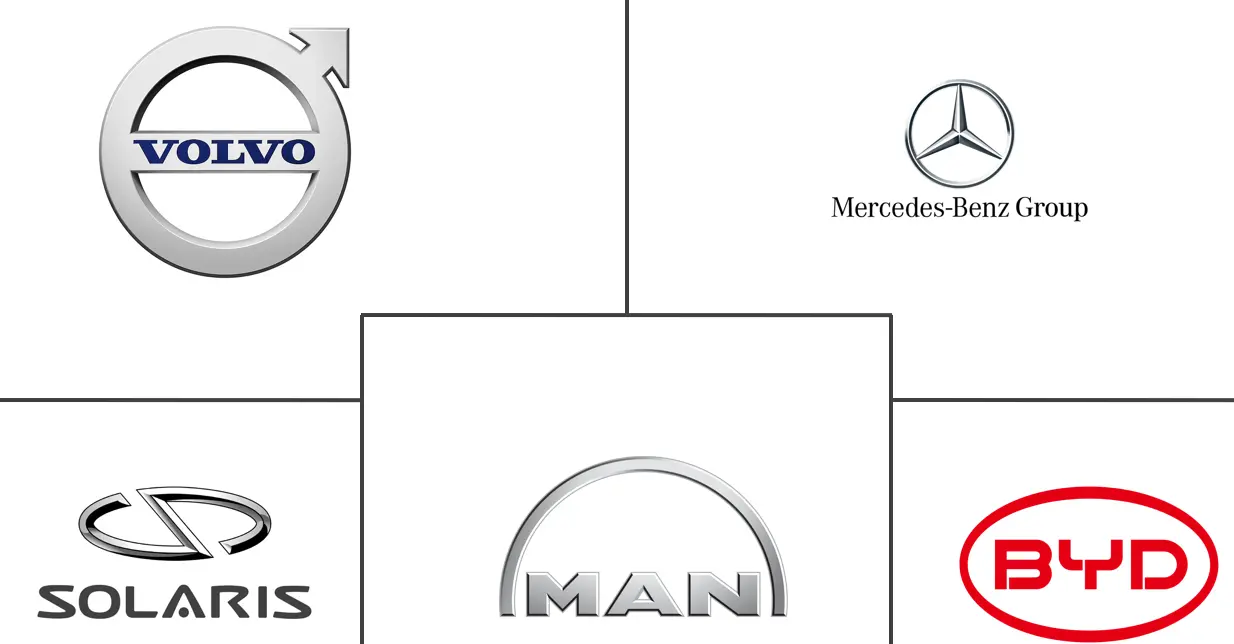Europe Bus Market Size and Share
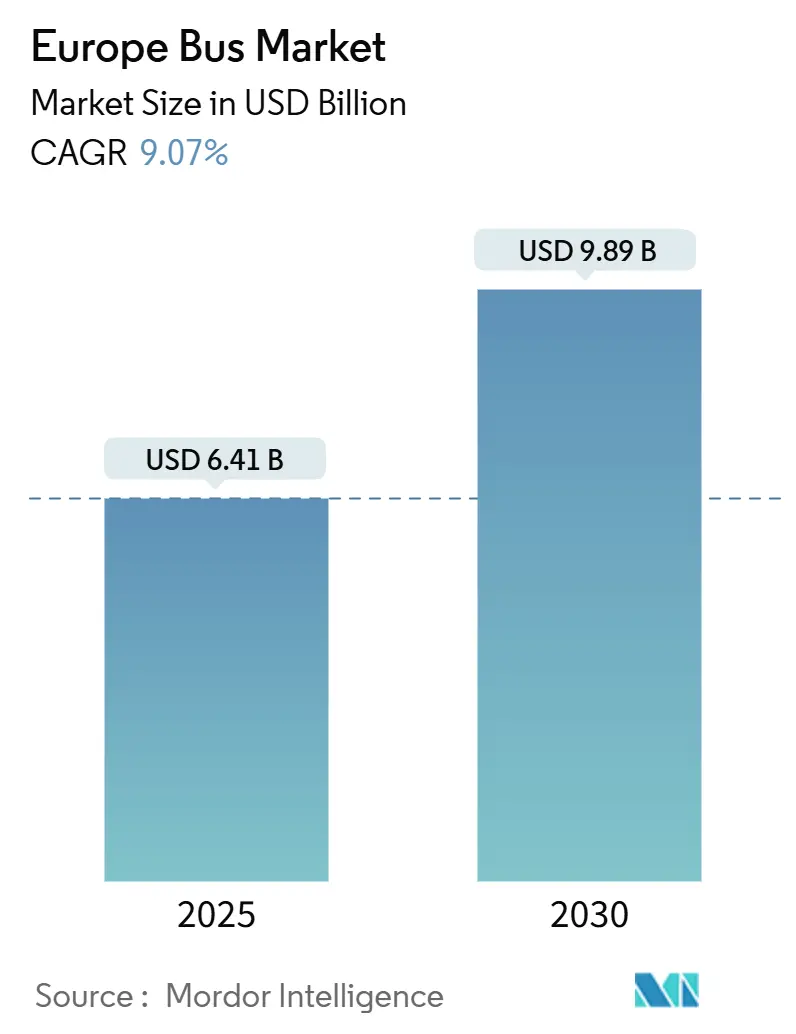
Europe Bus Market Analysis by Mordor Intelligence
The Europe bus market reached USD 6.41 billion in 2025 and is forecast to climb to USD 9.89 billion by 2030, reflecting a 9.07% CAGR as zero-emission mandates converge with infrastructure renewal across member states. Fleet operators favor battery-electric and, to a lesser extent, hydrogen fuel-cell platforms because lifetime operating costs continue to fall, charging ecosystems mature, and residual-value guarantees lower balance-sheet risk. Single-deck buses retain scale advantages, yet double-deck designs gain pace where vertical capacity is essential in dense urban cores[1]“Zero-Emission Buses Momentum in the EU,” Transport & Environment, transportenvironment.org. Transit agencies still run large diesel fleets, but procurement pipelines now prioritize electric models as total cost of ownership turns favorable, especially on high-utilization city routes. Germany anchors demand with almost one-quarter of regional revenue, while Italy leads growth on the strength of Recovery and Resilience Facility allocations.
Key Report Takeaways
- By deck type, single-deck configurations held 80.32% of the Europe bus market share in 2024, while double-deck buses are projected to expand at an 8.91% CAGR to 2030.
- By application, transit services accounted for 67.23% of the Europe bus market size in 2024 and intercity operations record the fastest 9.23% CAGR through 2030.
- By fuel type, diesel commanded a 58.34% share of the European bus market in 2024, yet battery-electric models exhibit the highest 8.22% CAGR to 2030.
- By seating capacity, the 31–50-seat class captured 48.23% share of the Europe bus market size in 2024; compact (≤30-seat) buses advanced at an 8.26% CAGR.
- By bus length, 9–12 m platforms led with 62.76% revenue share in 2024, while shorter variants (Less than 9 m) post an 8.76% CAGR.
- Germany contributed 24.76% of 2024 sales by geography, whereas Italy is the fastest-growing market at a 7.24% CAGR to 2030.
Europe Bus Market Trends and Insights
Drivers Impact Analysis
| Driver | (~) % Impact on CAGR Forecast | Geographic Relevance | Impact Timeline |
|---|---|---|---|
| EU Clean-Bus Mandate (2025/30 Targets) | +2.8% | EU-wide; strongest in Germany, France | Medium term (2-4 years) |
| Expansion of Urban Low-/Zero-Emission Zones | +1.9% | London, Berlin, Paris, Madrid | Short term (≤ 2 years) |
| EU Recovery and Resilience Facility Capital Spending | +1.6% | Italy, Spain priority | Medium term (2-4 years) |
| Post-COVID Public-Transport Ridership Rebound | +1.2% | Northern Europe focus | Short term (≤ 2 years) |
| Growth of Intercity Low-Entry E-Bus Tenders | +0.8% | Nordic countries, Germany, Netherlands | Long term (≥ 4 years) |
| OEM “Battery-as-a-Service” & Residual-Value Guarantees | +0.7% | Western Europe, UK, Germany pilots | Medium term (2-4 years) |
| Source: Mordor Intelligence | |||
EU Clean-Bus Mandate Accelerates Zero-Emission Adoption
The Clean Vehicles Directive obliges city authorities to ensure that 90% of new buses are zero-emission by 2030, creating a predictable volume for battery-electric and hydrogen platforms[2]“Clean Vehicles Directive Targets,” European Commission, ec.europa.eu. Germany front-loads compliance, targeting 45% emissions-free buses by 2025, pushing battery-electric buses to 49% of new city registrations in 2024, Bundesministerium für Digitales und Verkehr. OEMs scale output accordingly, and municipalities schedule depot retrofits ahead of procurement cycles, reducing lead times and mitigating supply-chain risk.
Urban Low-Emission Zones Drive Fleet Modernization
More than 325 low-emission zones operate in Europe, with 500+ planned by 2025 and at least 35 designated zero-emission by 2030. These zones slash urban pollutants—Brussels cut NOx 31% and black carbon 62%—forcing operators to accelerate retirement of legacy diesel fleets[3]“Urban Low-Emission Zones Impact,” Institute for European Environmental Policy, ieep.eu. Cities in the Netherlands move fastest, mandating zero-emission procurement from 2025 and full transition by 2030, positioning electric buses as the default choice in municipal tenders.
EU Recovery Facility Funding Accelerates Infrastructure
To maintain momentum toward the 2025 and 2030 AFIR goals, the EU urgently needs to secure €1.25 billion. The ideal sources for this funding are the remaining resources in existing instruments, such as the Recovery and Resilience Facility (RRF), European Regional Development Funds (ERDF), or the Cohesion Fund (CF). Additionally, filling the AFIF gap should precede Commissioner Tzitzikostas’ Sustainable Transport Investment Plan (STIP). Bulk tenders such as Rampini’s 280-unit electric order in Italy demonstrate how pooled funding compresses pricing and standardizes specifications, shortening the payback horizon for operators and OEMs.
Post-COVID Ridership Recovery Spurs Fleet Expansion
Public-transport trips reclaimed pre-pandemic footing across Northern Europe in 2024, and agencies have resumed their network expansion plans. The United Kingdom recorded 40% year-on-year growth in electric-bus sales to nearly 2,000 units, while Italy and Germany followed with 1,200 and 900 sales, respectively. Recovering passenger volumes support vehicle utilization and improve electric buses' economics by maximizing regenerative braking cycles and charging-in-depot uptime.
Restraints Impact Analysis
| Restraint | (~) % Impact on CAGR Forecast | Geographic Relevance | Impact Timeline |
|---|---|---|---|
| Phase-Down of National E-Bus Purchase Subsidies | -1.8% | Germany, France, Netherlands | Short term (≤ 2 years) |
| High Upfront Cost of Hydrogen Fuel-Cell Buses | -1.2% | EU-wide; Central Europe focus | Long term (≥ 4 years) |
| Depot Grid-Connection and Power-Capacity Delays | -0.9% | Urban centers; grid-constrained regions | Medium term (2-4 years) |
| Professional-Driver Shortages | -0.6% | EU-wide; acute in Germany, UK | Long term (≥ 4 years) |
| Source: Mordor Intelligence | |||
Phase-Down of National E-Bus Purchase Subsidies
Germany and France curtailed direct purchase rebates in 2024, shifting support toward accelerated depreciation and loan guarantees. Operators that timed tenders to annual budget cycles now confront funding gaps, which may defer deliveries in 2025 and 2026. Nonetheless, growing evidence that battery-electric buses beat diesel on total cost of ownership sustains long-term order books.
High Upfront Cost of Hydrogen Fuel-Cell Buses
Hydrogen models cost 2.3 times per kilometer than battery-electric equivalents in Italian pilot trials, leaving adoption largely in demonstration projects. Municipal buyers remain price-sensitive; with hydrogen at EUR 9/kg, breakeven against battery-electric is elusive. Unless hydrogen production costs fall near EUR 5/kg and refueling infrastructure proliferates, fleet electrification will stay battery-centric through the decade.
Segment Analysis
By Deck Type: Single-Deck Platforms Remain the Workhorse
Single-deck buses secured 80.32% of 2024 deliveries, underscoring their role as the operational default for most city networks. Standardized floor heights and flexible battery placement lower maintenance complexity, yielding faster depot turnaround times. Germany’s Hamburg alone ordered 350 single-deck eCitaro units for phased electrification. Double-deck variants record an 8.91% CAGR as London, Berlin, and Amsterdam chase higher passenger throughput on constrained corridors. Lightweight composite bodies and optimized energy management mitigate the historical penalty of taller structures, supporting the incremental shift toward double-deck capacity.
A broad aftermarket of parts and trained technicians further cements the single-deck value proposition. At the same time, double-deck platforms still need network upgrades—overhead clearance checks and specialized lifts - before scaling fleet ratios beyond niche routes. Manufacturers continue to evolve modular skateboard chassis that can underpin either format, thereby protecting residual values and smoothing operator change management.
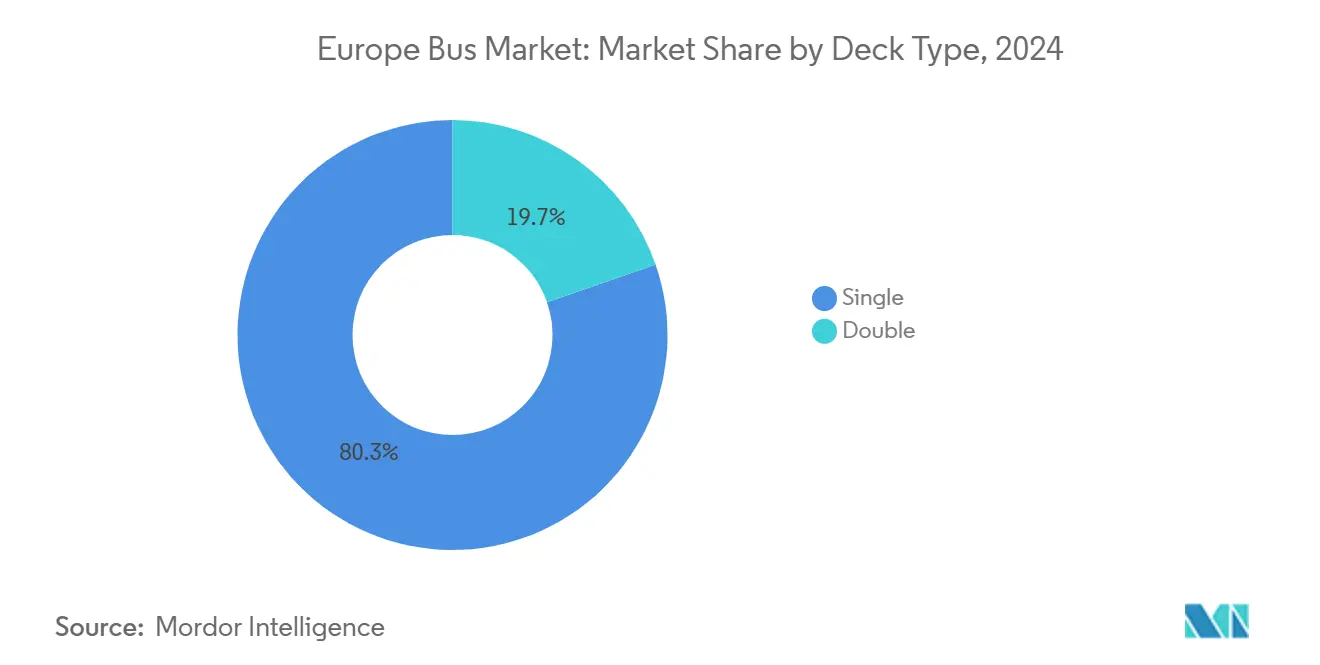
By Application: Transit Dominates but Intercity Gains Speed
Transit contracts represented 67.23% of revenue in 2024 because city authorities possess defined duty cycles and dedicated depot infrastructure that favor battery-electric operations. Regenerative braking and predictable dwell times improve total energy efficiency. Intercity lines, however, post the fastest 9.23% CAGR as range-extended models with 500-650 km capability cut through historical limitations. Solaris delivered 81 Urbino 15 LE units for Swedish regional services, validating early demand outside urban cores. School and airport shuttles also advance, but their combined volumes remain modest compared with municipal and intercity fleets.
OEMs differentiate through modular battery packs and high-power CCS2 charging, which permit mixed-use scheduling. Intercity operators increasingly specify Battery-as-a-Service contracts that shift battery residual-value risk to manufacturers, aligning asset-life expectations with eight-year public-service contracts.
By Fuel Type: Battery-Electric Surges Ahead
Diesel still holds 58.34% of active units, but its share erodes yearly as battery-electric models log an 8.22% CAGR. Operators cite predictable energy pricing, low drivetrain wear, and favorable maintenance profiles among their top motivations. Fuel-cell deployments stay under 3% of zero-emission sales, constrained by refueling infrastructure gaps and higher per-unit costs. Hybrid buses offer a transitional solution, yet dual-powertrain complexity boosts servicing overhead, nudging buyers toward pure electric orders where grid access is secure.
Policy momentum reinforces the shift; ten EU countries posted battery-electric shares above 80% in 2024 tenders, and the Netherlands reached 100%, rendering diesel a fallback only where grid constraints persist. As battery costs fall below USD 120/kWh by 2027, diesel parity on capital expenditure becomes plausible, permanently altering comparative procurement economics.
By Seating Capacity: Mid-Size Leads Right-Sized Operations
Buses seating 31–50 passengers captured 48.23% of 2024 demand, balancing capacity and energy use on intra-urban routes. The class benefits from optimized power-to-weight ratios that extend driving range without oversizing battery packs. Compact models (≤30 seats) register an 8.26% CAGR due to demand for agile, last-mile services in narrow city centers. Smaller vehicles also align with off-peak and on-demand operations as agencies deploy flexible scheduling platforms.
Energy-consumption studies show an inverse relation between passenger load and kilowatt-hour draw, indicating that midsize buses outperform larger types on per-capita emissions across most European duty cycles. Operators, therefore, re-evaluate fleet mix, retiring 18-ton legacy units in favor of lighter, more energy-efficient formats.
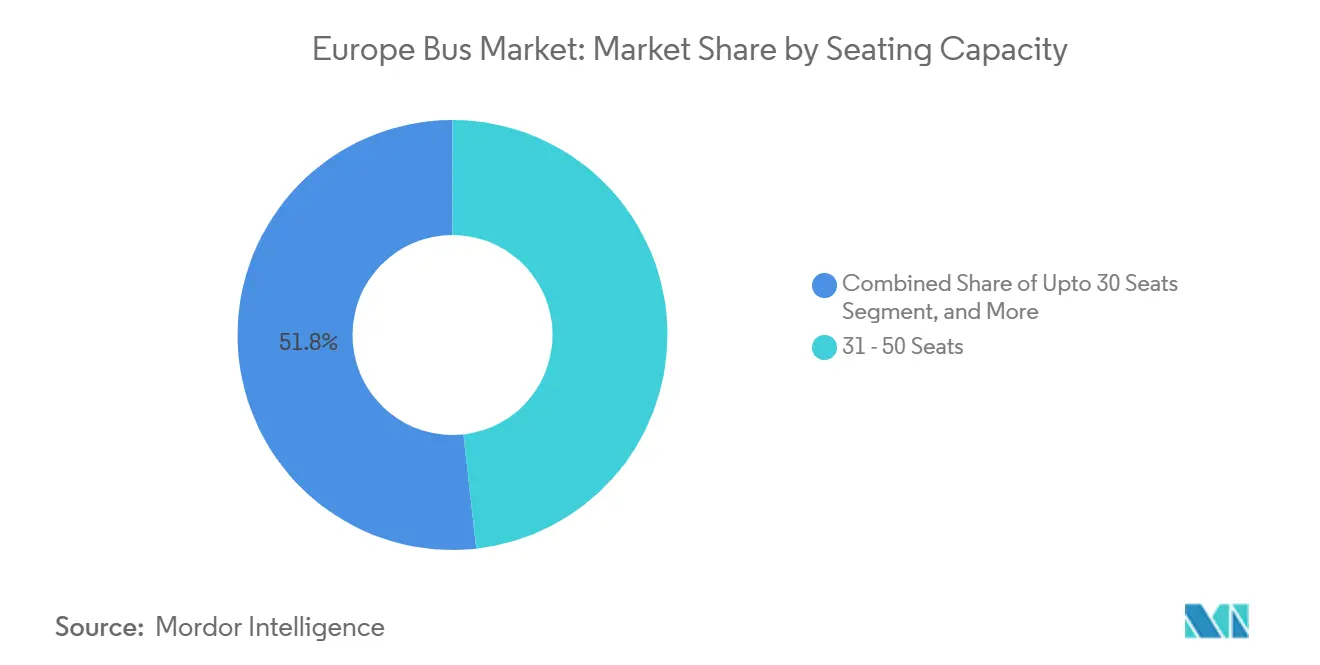
Note: Segment Shares of All Individual Segments Available Upon Report urchase
By Bus Length: Standard 9–12 m Formats Dominate but Shorter Buses Rise
Standard 9–12 m buses accounted for 62.76% of deliveries in 2024 because existing depots, lifts, and charging gantries are built around those dimensions. Consistent length allows OEMs to leverage common chassis platforms across diesel and electric variants, cutting tooling costs. Buses ≤9 m grow 8.76% annually as congested city centers impose turning-radius restrictions. They also achieve higher charging-point density per square meter within depots, easing expansion constraints without major civil works upgrades.
Articulated electric buses (Above 18m) face hurdles: charging alignment errors, bay-length limits, and heavier curb weights that reduce payload or battery capacity. Consequently, operators adopt a hub-and-spoke approach, dispatching a larger number of shorter vehicles rather than a smaller fleet of mega-buses, which supports higher service frequency and improved headways.
Geography Analysis
Germany maintained its 24.76% leadership by merging domestic OEM strength with early adoption of subsidy mechanisms that offset capital premiums for electric platforms. Hamburg’s multi-year framework for 350 eCitaro buses typifies large-batch procurement, and Munich, Cologne, and Berlin track similar roadmaps[4]“eCitaro Orders and Depot Projects,” Daimler Truck AG, daimlertruck.com. Although Berlin’s BVG still relies on diesel for cross-suburban express lines, it plans to electrify 80% of city routes by 2027, preserving Germany’s first-mover status.
Italy, growing at a 7.24% CAGR, benefits from EUR 50 million earmarked for zero-emission buses under the National Recovery and Resilience Plan. Rome’s 110-unit eCitaro order and Lombardy’s subsidies for school transport modernization propel deployments. Moreover, Italian tenders often bundle depot conversion and training, reducing integration risk for smaller municipalities.
France consolidates its share through OEM-municipality collaboration; Nantes, Marseille, and Lyon lock in multi-year contracts with Heuliez and Alstom to localize supply chains and accelerate delivery schedules. Despite post-Brexit supply-chain friction, the UK booked almost 2,000 electric units in 2024 under the Zero Emission Bus Regional Areas funding scheme. Spain leverages Barcelona’s hydrogen leadership and Madrid’s zero-emission zone, yet regional budget disparities temper uniform adoption across autonomous communities.
Nordic nations, though representing smaller absolute volumes, showcase the highest penetration rates; Finland and Iceland procured only battery-electric buses in 2024 tenders. Norway operates Europe’s largest all-electric depot above the Arctic Circle, illustrating resilience in extreme climates. Eastern Europe lags behind due to infrastructure financing hurdles, but EU cohesion funding begins to unlock pilot deployments in Poland and Romania, signaling future convergence in adoption curves.
Competitive Landscape
The Europe bus market is moderately concentrated; the six largest suppliers are Mercedes-Benz, Volvo, MAN, Scania, Solaris, and BYD. Traditional brands preserve customer loyalty through vast service networks and established parts pipelines, yet challengers gain ground by fielding purpose-built electric platforms. Solaris delivered 705 zero-emission buses in 2024, including 245 hydrogen units[5]Solaris Bus & Coach, “2024 Sales and Hydrogen Leadership,” solarisbus.com.
Strategic ventures intensify. Daimler Buses took a 49% stake in software firm SINOS to enrich fleet diagnostics and predictive maintenance tools, and Scania earmarked 40,000 public chargers by 2030 to embed itself deeper into infrastructure conversations. Chinese entrants contribute 20% of post-2017 battery-electric deliveries, pressuring European OEMs to compress cost structures and accelerate plant retooling timelines.
White-space competition emerges in intercity electric coaches; just 200 buses entered service in 2023 versus 6,000 municipal units. Iveco’s Crossway ELEC and MAN’s Lion’s Coach E signal a technology race to crack long-range duty cycles before hydrogen infrastructure reaches cost parity. Meanwhile, VDL and Ebusco raise capital to scale lightweight composite bodies that promise 10% energy-efficiency improvements over conventional aluminum shells.
Europe Bus Industry Leaders
-
Volvo Buses
-
Mercedes Benz Group AG
-
Solaris Bus & Coaches
-
MAN Truck & Bus
- *Disclaimer: Major Players sorted in no particular order
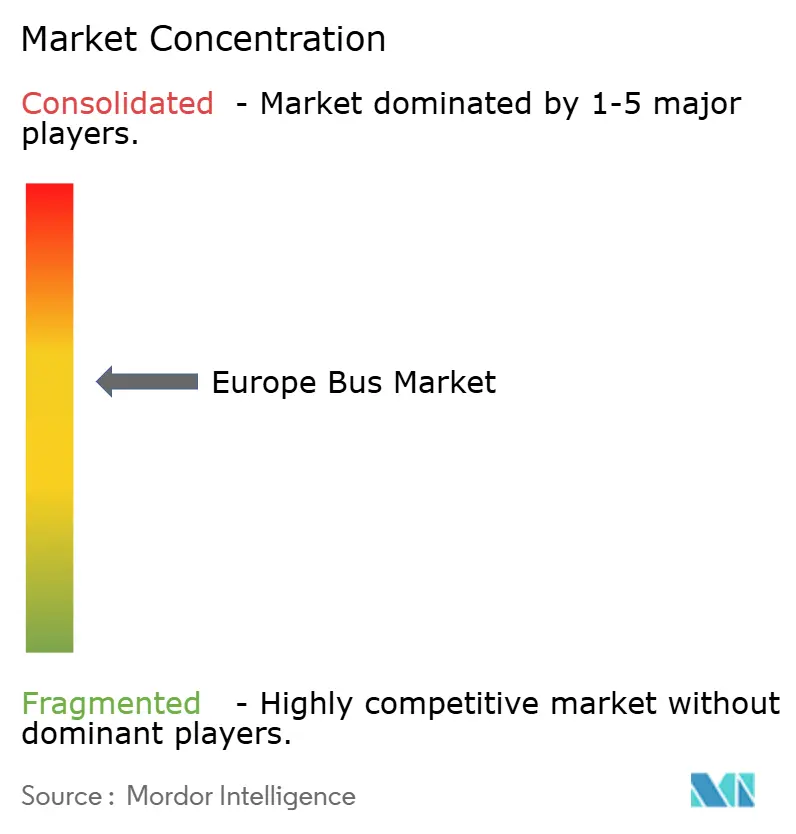
Recent Industry Developments
- May 2025: Daimler Buses wins contract to build an electric-bus depot in Lüneburg, Germany, with 20 charging points and 20 eCitaro units, backed by EUR 9.6 million federal funding.
- May 2025: VAG Nuremberg receives 31 eCitaro G articulated buses, cementing the city’s shift to electric public transport.
- December 2024: Iveco unveils Crossway ELEC with 450–500 km range at Autocar Expo in Lyon.
- November 2024: Ebusco launches EUR 36 million rights issue to accelerate production capacity.
Research Methodology Framework and Report Scope
Market Definitions and Key Coverage
Our study defines the Europe bus market as revenue generated from the sale of new, factory-built single-deck, double-deck, articulated, and coach-style buses with a gross weight above 5 metric tons that are licensed for public or private passenger transport across EU-27, U.K., EFTA, and candidate countries. According to Mordor Intelligence, this scope follows UNECE M2/M3 classifications and captures diesel, hybrid, battery-electric, and fuel-cell drivetrains while leaving out micro-shuttles and aftermarket services.
Scope Exclusions: The model omits revenue from van-derived minibuses, second-hand imports, and parts or maintenance contracts.
Segmentation Overview
- By Deck Type
- Single
- Double
- By Application
- Transit Bus
- Intercity Bus / Motorcoach
- School Bus
- Other Applications
- By Fuel Type
- Diesel
- Battery Electric
- Plug-in Hybrid
- Fuel Cell Electric
- Other Fuel Types
- By Seating Capacity
- Up to 30 seats
- 31 - 50 seats
- More than 50 seats
- By Bus Length
- Up to 9 m
- 9 - 12 m
- More than 12 m
- By Country
- Germany
- France
- United Kingdom
- Italy
- Spain
- Rest of Europe
Detailed Research Methodology and Data Validation
Primary Research
Interviews with European fleet operators, leasing banks, chassis OEM product heads, and charging-infrastructure planners helped us test secondary findings, sense-check adoption hurdles, and benchmark average selling prices across diesel and zero-emission variants. Surveys with city procurement officers in Germany, Italy, and the Nordics validated replacement cycles and subsidy pass-through assumptions. This direct feedback let us tighten cost-of-ownership differentials embedded in our findings.
Desk Research
We began with open statistics from Eurostat passenger-kilometer tables, ACEA new bus registrations, and EU Clean Vehicles Directive quota filings, which framed baseline demand. Additional context came from national transport ministries, DVV Media Group's e-bus deployment reports, trade data lodged with UN Comtrade, and peer-reviewed papers on battery cost curves. For company-level clues, our analysts tapped D&B Hoovers and Dow Jones Factiva, while Marklines supplied model-specific production totals. These sources, cited as illustrations only, feed an internal repository that Mordor analysts reference for every quarterly refresh; many further publications were also consulted for cross-checks and clarification.
Market-Sizing & Forecasting
A top-down reconstruction starts with 2024 new-registration and import-export data, which are then valued using median OEM invoice prices adjusted for incentive offsets; selective bottom-up supplier roll-ups act as a plausibility screen. Key model drivers include battery-pack price per kWh, Clean Bus quota escalation, municipal tender pipeline, real GDP growth, and diesel-to-BEV total-cost-of-ownership parity timing. Multivariate regression links these variables to historic unit swings, and an ARIMA overlay captures cyclical shocks before projections extend to 2030. Gaps in smaller economies are bridged using penetration-rate analogs from demographically similar peers.
Data Validation & Update Cycle
Outputs undergo variance scans against ACEA quarterly releases, Euro exchange-rate re-runs, and headline OEM disclosures; anomalies trigger analyst rechecks. Two reviewers sign off before publication. Reports update annually, with interim edits whenever subsidy schemes, major tenders, or emission rules materially shift the baseline.
Why Our Europe Bus Baseline Commands Reliability
Published estimates often diverge because firms pick dissimilar vehicle classes, price stacks, and refresh cadences.
Key gap drivers include whether coaches and minibuses are folded in, how electric-bus incentives are netted, and the currency year used for conversions. Mordor's disciplined scope alignment, annual refresh, and dual-path validation keep our figures consistent and decision-ready.
Benchmark comparison
| Market Size | Anonymized source | Primary gap driver |
|---|---|---|
| USD 6.41 Bn (2025) | Mordor Intelligence | |
| USD 10.6 Bn (2025) | Global Consultancy A | Adds long-distance coaches and shuttle vans without de-duplication |
| USD 14.44 Bn (2024) | Industry Journal B | Bundles aftermarket parts, uses 2023 FX and linear CAGR carry-forward |
| USD 5.12 Bn (2024) | Regional Consultancy C | Covers only eight core EU states and omits zero-emission units |
These comparisons show that once scope mismatches and pricing assumptions are stripped away, Mordor's balanced approach offers the most transparent, reproducible baseline for investors and planners.
Key Questions Answered in the Report
What is the current size of the Europe bus market?
The Europe bus market stands at USD 6.41 billion in 2025 and is projected to reach USD 9.89 billion by 2030.
Which segment holds the largest share of the Europe bus market?
Single-deck buses lead with 80.32% share of 2024 deliveries.
Which fuel technology is growing fastest in the Europe bus industry?
Battery-electric buses post the highest 8.22% CAGR as lifetime operating costs drop and zero-emission rules tighten.
What are the main restraints on Europe’s bus electrification?
The two leading barriers are the phase-down of purchase subsidies and the high upfront cost of hydrogen fuel-cell buses relative to battery-electric options.
How are operators addressing residual-value risk for batteries?
Many agencies adopt Battery-as-a-Service contracts, where the OEM retains battery ownership and guarantees performance over the contract term.
Page last updated on:
